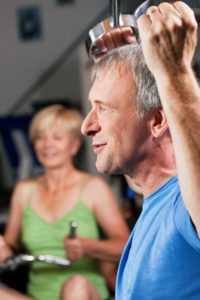A Well-Rounded Baby Boomers’ Exercise Routine

Tid Bits of Info
- Always get cleared to begin an exercise routine by your doctor.
- Progress and don’t be afraid to try new exercises and activities.
- Try to exercise 3-4 x per week at a minimum.
- Never push yourself to exhaustion. There is always tomorrow. Watch what you eat!
- Seek the advice of a Physical Therapist if you injure yourself or you need guidance towards a proper exercise routine.
As more and more Baby Boomers face the challenges of growing older, they are embracing fitness programs as a way to maintain their health and continue to enjoy active lifestyles. When people enter the 4th, 5th, or 6th decade, their bodies lose some resiliency. Just because youth is fading doesn’t mean that people have to slow down. A well-rounded Baby Boomers’ exercise routine can help reduce injuries and the onset or frequency of conditions associated with aging like heart disease, Type II diabetes, osteoporosis and some neurological conditions.
People entering their 40s, 50s, or 60s often choose a regular fitness regimen as a way of improving health conditions and maintaining a high quality of life. Exercise has been proven to be the single most important part of someone’s routine to help prevent heart disease and increase length of life. Both men and women can benefit from regular training, but some studies have shown that women benefit more than men from regular exercise. Prior to beginning the routine, it is important to get medical clearance from the doctor. The guidance of a Physical Therapist can play a vital role developing a Baby Boomers exercise regimen.
Creating a Well-Rounded Baby Boomers’ Exercises Regimen
Here are some initial suggestions for creating a balanced routine. First, a regimen should include exercises that will address the following:
- the cardiovascular system
- muscular strength and endurance
- flexibility
- balance or neuromuscular control
- proper nutrition
For those who are just starting an exercise routine, it is important to begin slowly and progress steadily. Exercising 2-3 times per week should be the minimum. There is no reason to avoid some kind of exercise every day of the week if the routine incorporates different elements of the regimen on consecutive days.
Cardiovascular Training
It is recommended that you should perform cardiovascular exercises 4-5 times per day for a minimum of 30 minutes. Ideally, 30 to 60 minutes of cardiovascular exercise at a rate of approximately 60 – 70% of the maximum heart rate (roughly, 220 – your age x .60 or .70) performed 4-5 x per week would be fantastic. If shedding a few pounds is a goal, you can see significant results if you plan to perform this aspect of the routine for 45-60 min or more. Several shorter periods of cardiovascular exercise session in a given day can also yield great benefits. There appears to be a positive, cumulative effect on the body providing the total time that the heart rate is elevated equals 30 – 60 minutes per day.

Strength Training
Strength training is a must. Our bodies begin to lose muscle mass when we enter this stage of our lives. Some studies suggest that a person can lose up to ½ pound of muscle mass per year once they turn 50. The muscle structure of people who have not been physically active or have not participated in a strength-building program is most likely deconditioned and much weaker than it could be with a little effort
Strength training exercises should focus on the whole body. Resistance training can be accomplished in many ways. Lifting weights, pulling on resistance bands, using machines or your own body weight, and various “fad” type exercise routines can be used to develop strength providing they are used properly. Most people will experience a positive effect from the exercise routine if they perform 2-3 sets of 10-15 repetitions 2-3 times per week. The routine should focus on the whole body and special attention should be given to the core. The core musculature is the foundation for the entire body. The ability of the core to control the spine and pelvis makes movement in the peripheral joints much more efficient.
Joint Flexibility
Flexibility of the joints in this age group usually begins to decrease due to the natural aging process of soft tissue and prolonged postural positioning over a long period of time. Many people have neglected this aspect of an exercise routine for years. The soft tissue has shortened due to working in jobs that require sitting or assuming certain postures over a long period of time.
Over the years, the soft tissues adapted to a shortened position and gradually lead to a loss of flexibility. The flexibility of an area that has adapted to a shortened position can be restored with a lot of effort. The time spent on stretching must be extensive, but does not have to be intensely painful. The analogy of stretching leather is best used when trying to depict what has to occur for someone to gain flexibility in a body part that has lost it.
If the stretching is done too aggressively and not held for a prolonged period of time, there can be soft tissue damage or nothing that occurs. If the stretch is held for 20 – 30 seconds or longer in a position that elicits a slight amount of discomfort, the soft tissue will begin to “creep” or change and lengthen. It is believed that the best time to stretch is after an exercise routine because the soft tissue temperature is elevated and more pliable.
Balance Development
The routine must include a portion of balance development. The loss in strength due to muscle loss can lead to difficulty maintaining balance when someone changes positions too quickly or is on un-level or un-stable ground. There are numerous systemic conditions that can lead to decreased sensation and neurological impulses directed to and from the muscles. This can lead to instability and unsteady gait. This can cause a person to lose their balance and fall injuring many different body parts. Simple drills such as balancing on one leg with the eyes open and closed can help the nervous system stay “in tune” with the musculoskeletal system. This keeps the reflexive responses needed to maintain balance sharp and ready to “fire.” Doing these drills in conjunction with a whole body workout will help someone be able to maintain their balance and avoid falling.
The Baby Boomer generation is probably the first generation that recognized the benefits of a well-designed, whole body exercise routine. They were not always willing or able to comply with a regular routine, but they knew that this type of regimen could enhance the quality of their life and in some instances lengthen their life span. Fortunately, the exercise industry has branched out to all age groups and has enabled almost anyone to perform a meaningful program if they chose to do so. The Baby Boomers want to be active and live a full life and realize that being in good shape can help them achieve this goal.
























